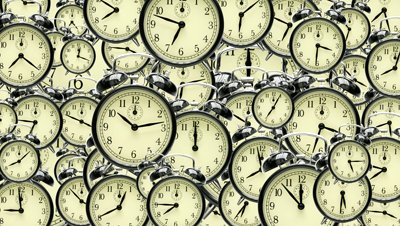Danish Time
If you plan to visit Denmark, it is important you understand that Danish time, Danish dates and the Danish clock are expressed a little bit differently. Not knowing - can cause alot of confusion. The Danes use a different method of expressing time and dates.
When I first mentioned this to a friend visiting us, he said, "Oh my gosh - you mean to tell me that Danish Time is different from the rest of the world?" Well... yes and no.
My wife first experienced this when she boarded a bus one day at about 10:00 am. To an American, this period of the day would still be morning, so she said, "Morgen" to the bus driver. He immediately smiled and said something to her, which with her limited knowledge of Danish, she took to mean that it was no longer morning, and it was more appropriate to say, "Goddag".
We discovered that Danes have different ideas about when morning, afternoon, evening and night are.
Don't worry, there is no mystical Nordic Clock System that you need to learn. But as Ricky would say, "Lucy, you got sum 'splainin' to do!" (sorry that was a clue to my age)
Periods of the Day
When Danes talk to you about Danish time, they often use various terms to denote certain time periods in a day. Whereas Americans have morning, afternoon, evening, and night, the Danes have many more time periods over the course of 24 hours.
When someone says they want to meet at Frokost Tid, that means lunch time, which is 12noon to 1PM. It doesn't matter if you usually have lunch at 11:30AM or 1:30PM, frokost is the time between 12noon and 1PM.
There are seven such Danish time periods and they are:
- Morgen is from 6am to 9am (0600-0900)
- Formidddag is 9am to 12 noon (0900 - 1200)
- Frokost is 12 noon to 1pm (1200 - 1300)
- Eftermiddag is 12 noon to 6pm (1200 - 1800)
- Aften is 6pm to 12 midnight (1800 - 2400)
- Nat is midnight to 6am ( 2400 - 0600 )
You can learn more about the Danish language or pick up some useful phrases.
Danish Time - The 24 Hour Clock
Danish time is calculated using the 24-hour clock -- not the 12-hour clock with AM and PM. If you are not familiar with the 24-hour clock, or military clock, you will need to adapt in order to understand time in Denmark.
The time is expressed with 4 numbers (00:00) Midnight is the start of the day, so midnight is written 00:00. The first two numbers are the hour and the last two numbers are the number of minutes after the hour.
So from midnight to 9am, the first digit would always be "0". 2AM is written as 02:00; 5:38 am is written 05:38; when you get to 10:00am and beyond (up to 1pm), you write, of course, 10:15. This is all very similiar to the normal 12-hour clock. Where it gets confusing for people is when you get past 1pm.
1:00pm is written as 13:00; 4:45 pm is written as 16:45. This continues all the way to midnight. The largest numbers will be 23:59 which is 11:59 pm, and then you start over with 00:00.People are often confused when the time starts with 13, 17, 21, etc., and they have a hard time figuring out the hour. The simplest method is to subtract 12 from the first two digits. If the time say 19:50, subtract 12 from 19 and you get 7:50 (that will be PM).
NOTE: The military clock is normally written with : between the hour and minutes, but in Denmark it is written with a "." (period or full stop). So you will see Danish time written as 14.15, 17.30, 05.00, etc.

Speaking the Time
So far, so good, but here is where it gets more complicated, because how you write/read the time is not the same way you say the time. It is very rare that you will hear the Danes say the Danish time as a military time. They revert back to the 12-hour clock when speaking.
Odd, but TRUE! But there are exceptions.
So when you speak the time, you will say the time is 7 for 7am in the morning and if it is 7pm, you add "i aften" (this evening).
There are exceptions to this. When talking about programs, time tables for trains and buses, start times of shows, movies, etc., then you say the time in military time.
If that's not confusing enough for you, just "wait til I get going!" There is more.
Expressing Time in Speech
When you start to learn Danish, you will probably start pulling your hair out because of how you have to say the Danish time. It can be said in many different ways, but what you have to remember is Danes think ahead to the next hour and express it that way.
Let me 'splain. If the time is 1:30pm, or 13.30, you don't say the time is 1 and 30 minutes or 30 minutes past 1. You move ahead to the next hour. So, 1:30 pm is said "half two" (halv to). 6:30pm is "half seven" (halv syv), and so it continues for every half hour expressed.
If it is 1 to 29 minutes after the hour, you say the number of minutes after the hour (6 minutes after 2, etc.) Now when you get close to the half hour, you can express the time as 10 minutes to the half hour. So if the time is 4.23pm, you would express it as "7 minutes to half 5". Is that confusing? Yes, it is, but that's how it is done.
From the half hour to the full hour, you can say the time after the half hour. If it is 6:38pm, you express is as "8 minutes after half seven", or you can say it is "22 minutes to seven".
Note: When using the minutes to and after the half hour, you usually don't go over 10 minutes on either side. So if it is 19 minutes after the hour, you wouldn't express it as "11 minutes to the half". You would say "19 minutes after the hour".
You also use expressions like "quarter before" or "quarter after" the hour.
After a while you will get used to it, but at first it can be a bit overwhelming.

Danish Calendar
Well, have you had enough talk of Danish time? Time for a change?
Let's talk about the calendar. You may ask, what is so different about the Danish calendar?
The Danes use the same calendar as other Germanic countries, but there are a few things you might like to know, one of which can be quite helpful and could save you a bit of embarrassment.
First, when you write the names of the months and days in Danish, they are not capitalized as they are in America or Britain. In Danish, they would be capitalized only if used as the first word in a sentence.
Second, the real confusion with the Danish calendar may come when you write out the dates numerically.
For example, in America we would write a date as: June 4, 2015. In Denmark we write the same date as: 04 juni 2015. The day comes before the month. Writing this same date numerically, we would write it this way: 6/4/2024 in English and 04.06.2024 in Danish.
You might read 04.06.2024 and think you were going to a party or meeting on the 6th of April in 2015, but it would actually be on June 4th in 2015. You would be two months off -- not a mistake you would want to make twice! So remember, the day and month are reversed. The Danish version also uses a period or full stop between the numbers instead of the forward slash.
So check those dates again or you may be several months late or early for your next appointment!
But wait there is more! Not confused enough? In Denmark it is very common for people to use week numbers versus dates. I am going on holiday /vacation / ferie in week 27. When is week 27?, you may ask yourself.
Weeks are listed as week 1 to week 52 (sometimes week 53) starting from the first week in the year. The week starts on a Monday except on the first week of the year where it starts on the 1st of January. 1.1.2024
In 2015, the first week actually starts on a Thursday and that is week 1. The first 3 days of the week are actually considered week 53 of year 2014.
Week 2 starts on January 5th and so forth. When you buy a calender in Denmark, the week numbers are ALWAYS listed. So to answer the question above, week 27 is June 29th to July 5th, 2015.
Hope that was enlightening, since it will play a big part in your expat lives. If you think that was fun, how about learning about something other than Danish Time - how about Danish numbers!
|
|
|
If you found this page helpful, please give a google+ and or a facebook like at the top of the screen, so others can also find this information. Thank you.
Please feel free to comment on this subject
Do you have a helpful tip or comment on this subject that you would like to share? Please leave comments below.
What Other Visitors Have Said
Click below to see contributions from other visitors to this page...
It's normal in Europe Not rated yet
Exactly the same time naming and dates rules are used in Poland except for using weeks numbers. I think that it's the common way that people talk or think …

Quality facemasks are in high demand and hard to find. We have found these quality masks here for only 14kr. Going fast so get yours today! Click Here.
Recent Articles
-
Home Furnishing Shops in Denmark
Feb 16, 24 11:10 AM
There are many home furnishing shops in Denmark, yet not all have physical stores nor are they well known. To find the best prices ind quality, check out some of these shops -
Useful Danish Phrases
Oct 07, 21 07:28 AM
Learning a few useful danish phrases or words can go a long way to making your stay or visit in Denmark more enjoyable. -
Aarhus Attractions
Oct 07, 21 07:08 AM
The number of Aarhus attractions may not be as big as Copenhagen, but there is still alot to see and do in this Danish city.



